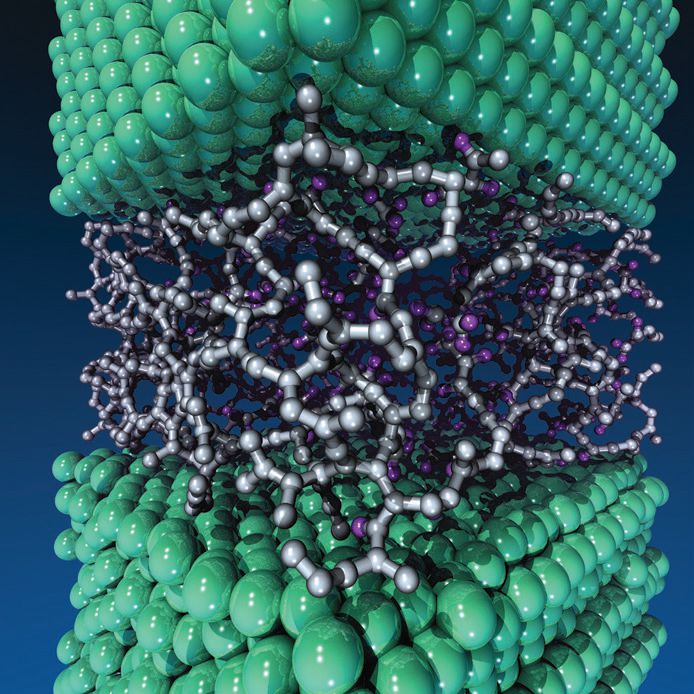Tribocatalysis: A new extreme pressure lubrication approach
Dr. Neil Canter, Contributing Editor | TLT Tech Beat October 2016
New research represents a promising alternative to formulating lubricants with conventional extreme pressure additives.
KEY CONCEPTS
• A new approach to extreme pressure lubrication has been developed through the use of tribocatalysis.
• Under severe operating conditions, a nanocoating containing a catalyst based on a transition metal facilitates the in-situ conversion of a lubricant base oil to form a tribofilm containing amorphous carbon species.
• The tribofilm demonstrates superior reductions in coefficient of friction and wear.
THE EFFORT CONTINUES TO DEVELOP LUBRICANTS that can exhibit low coefficient of friction and low wear characteristics under stressful operating conditions for long operating periods. But the question is now being raised about whether there are any new technologies available to further improve the performance of the lubricant.
Dr. Ali Erdemir, STLE Fellow and a Distinguished Fellow at Argonne National Laboratory near Chicago, says, “Over the past century, lubricant scientists have made tremendous progress in improving the quality and durability of formulated oils and greases. But a limit on how much more improvement can be gained from developing new lubricants in this traditional manner may have been reached.”
Erdemir and his colleagues feel that there must be an alternative way to manipulate lubricant molecules to transform them into carbon-based species such as diamond or diamond-like carbon (DLC) species, which have demonstrated a significant reduction in coefficient of friction. A past TLT article discusses the interaction of a DLC-coated surface with a graphene-coated surface (1). Computer simulations conducted by Argonne researchers showed evidence of superlubricity for the first time at the macroscale. Superlubricity occurs when the coefficient of friction drops below 0.005.
Erdemir believes that a logical strategy is to see what can be done to find a suitable catalyst for facilitating the conversion of lubricant molecules to diamond and DLC. He says, “Of particular interest to us is how to tap into the base oil side, which constitutes approximately 70%-90% of most lubricants. Most base oils are based on hydrocarbon molecules, which is leading us to identify catalysts that can effectively convert them into carbon species.”
One catalyst type that is frequently used with hydrocarbons is transition metals such as cobalt, molybdenum, nickel, tungsten and vanadium. They are used in such applications as base oil processing.
Erdemir and his colleagues are now reporting that a catalyst system has been developed that will convert lubricants to amorphous carbon species under extreme pressure lubrication conditions in a process known as tribocatalysis.
ULTRADURABLE, SELF-LUBRICATING TRIBOFILM
The researchers discovered the concept of tribocatalysis through evaluation of a martensitic chrome steel alloy (AISI 52100 steel) coated with a material based on molybdenum nitride and copper (used as a catalyst) in the commonly used ball-on-disk test. The disks and balls used in the test are evaluated in pure PAO 10 and also with a fully formulated 5W-30 synthetic passenger car engine oil.
Erdemir says, “We determined the coefficient of friction and total volumetric wear during a 10-hour test period, which is used to evaluate the durability of the nanocoating. PAO is selected because it is the premier synthetic base oil chemistry used by the lubricant industry. We also wanted to see how the nanocoating interacted with a fully formulated engine oil.”
The coefficient of friction for the nanocoated ball and disk in PAO 10 remained constant at 0.08. In contrast, the coefficient of friction for the untreated ball and disk in PAO 10 fluctuated between 0.02 and 0.12 during the test. The value found in the fully formulated engine oil is 0.1.
The total volumetric wear value for the nanocoated ball and disk in PAO 10, 7.35 x 10-15 m3 compares favorably to the values obtained with the untreated ball and disk in PAO 10 (1.34 x 10-12 m3) and in the fully formulated engine oil (1.26 x 10-13 m3).
Spectroscopic analysis of a thin tribofilm detected by the researchers on the nanocoated ball after the tests with PAO 10 and the fully formulated engine oil indicates that the main component is amorphous carbon with high sp2 bonding. This is a significant finding because the past work on superlubricity showed that a carbon film responsible for the low coefficient of friction exhibits a similar structure.
Erdemir says, “The tribofilm formed from the nanocoating in PAO 10 and the fully formulated engine oil is also detected with all of the other mineral oil base stocks available to the lubricant industry, natural gas and with ester-based vegetable oils such as soybean oil.”
Erdemir’s colleague, Dr. Subramanian Sankaranarayanan, computational nanoscientist at Argonne, conducted a theoretical analysis to understand the mechanism for the formation of the tribofilm. He says, “The simulation modeling provides a good picture of what is occurring at the atomic level.”
Under the severe extreme pressure conditions created as the ball and disk slide against each other, the hydrocarbons in the base oil are converted into a hydrogenated amorphous carbon by the copper catalyst. Hydrogen is eventually released through a dehydrogenation process and carbon-carbon backbone bonds split at the same time to form shorter amorphous carbon fragments. The net result is the preparation of an amorphous carbon-based tribofilm that is consistently regenerated under the experimental conditions. This feature means that the tribofilm is ultradurable, self-healing and self-lubricating.
Figure 1 shows the formation of the amorphous carbon tribofilm between the two sliding metal layers.
 Figure 1. The formation of an amorphous carbon tribofilm from the reaction of a lubricant base oil with a transition metal catalyst represents a new way to produce an extreme pressure additive in-situ. (Figure courtesy of Argonne National Laboratory.)
Sankaranarayanan conducted his work at elevated temperatures typical of those in tribological environments. He says, “We did not see any reaction taking place at 600 K. The conversion of the lubricant base oil molecules to the amorphous carbon tribofilm was only seen at elevated temperatures such as 1,000 K.”
The phenomenon discovered by the researchers is very similar to how extreme pressure additives formulated into lubricants becoming activated. Erdemir says, “Tribocatalysis uses the molecules of the base oil to form an alternative extreme pressure additive in-situ.”
At a time when several currently used extreme pressure additive chemistries have come under regulatory scrutiny, the research finding represents a promising alternative to formulating lubricants with conventional extreme pressure additives. Erdemir says, “Our approach has a good deal of flexibility because we can design the coating and the catalyst based on the requirements of the application. In the future, we believe that a different catalyst besides copper should be used and have found nickel to be very promising.”
The nanocoating initially used displays a thickness of 600 nanometers. Erdemir says, “We prefer the coating to have a thickness of three to five microns but realize that economics may preclude a larger thickness.
Researchers will continue to evaluate how the formation of the tribofilm affects the performance of used lubricants. The hope is that it will not only extend lubricating operating life but improve performance.
Figure 1. The formation of an amorphous carbon tribofilm from the reaction of a lubricant base oil with a transition metal catalyst represents a new way to produce an extreme pressure additive in-situ. (Figure courtesy of Argonne National Laboratory.)
Sankaranarayanan conducted his work at elevated temperatures typical of those in tribological environments. He says, “We did not see any reaction taking place at 600 K. The conversion of the lubricant base oil molecules to the amorphous carbon tribofilm was only seen at elevated temperatures such as 1,000 K.”
The phenomenon discovered by the researchers is very similar to how extreme pressure additives formulated into lubricants becoming activated. Erdemir says, “Tribocatalysis uses the molecules of the base oil to form an alternative extreme pressure additive in-situ.”
At a time when several currently used extreme pressure additive chemistries have come under regulatory scrutiny, the research finding represents a promising alternative to formulating lubricants with conventional extreme pressure additives. Erdemir says, “Our approach has a good deal of flexibility because we can design the coating and the catalyst based on the requirements of the application. In the future, we believe that a different catalyst besides copper should be used and have found nickel to be very promising.”
The nanocoating initially used displays a thickness of 600 nanometers. Erdemir says, “We prefer the coating to have a thickness of three to five microns but realize that economics may preclude a larger thickness.
Researchers will continue to evaluate how the formation of the tribofilm affects the performance of used lubricants. The hope is that it will not only extend lubricating operating life but improve performance.
Additional information can be found in a recent article (2) or by contacting Greg Cunningham, public information officer at Argonne at gcunningham@anl.gov.
REFERENCES
1. Canter, N. (2015), “Superlubricity: Seen at the macroscale for the first time,” TLT, 71 (10), pp. 10-11.
2. Erdemir, A., Ramirez, G., Eryilmaz, O., Narayanan, B., Liao, Y., Kamath, G. and Sankaranarayanan, S. (2016), “Carbon-based tribofilms from lubricating oils,” Nature, 536 (7614), pp. 67-71.
 Neil Canter heads his own consulting company, Chemical Solutions, in Willow Grove, Pa. Ideas for Tech Beat can be submitted to him at neilcanter@comcast.net
Neil Canter heads his own consulting company, Chemical Solutions, in Willow Grove, Pa. Ideas for Tech Beat can be submitted to him at neilcanter@comcast.net.